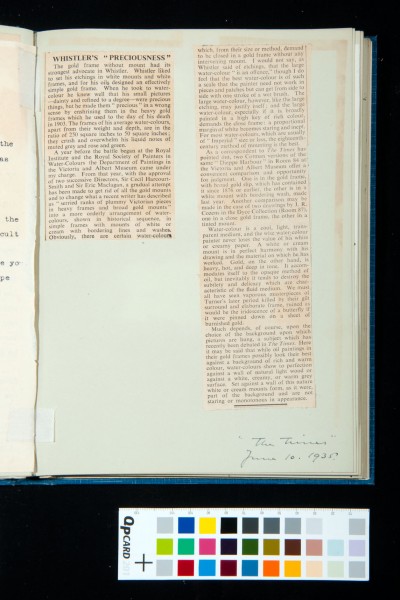Cotmania. Vol. X. 1934-5
Archive: SDK Sydney Decimus Kitson Archive
Reference Number: SDK/1/2/1/10
Page: 16 recto
-
Description
Press cutting by Martin Hardie on Whistler's "Preciousness" regarding framing
Martin Hardie, then curator of Prints and Drawings at the V&A, wrote an article for The Times discussing the artist James Whistler's likeness for gold frames for his watercolours. Hardie goes on to write about the gradual attempt to get rid of gold mounts for watercolours and change to white or creamy mounts. Hardie makes reference to Cotman's "Dieppe Harbour" - comparing two versions of the same painting where one is in a gold frame and one is with a white mount.
Date: 1934-1935
-
Transcription
{press cutting}
WHISTLER'S "PRECIOUSNESS"
The gold frame without mount had it's strongest advocate in Whistler. Whistler liked to set his etchings in white mounts and white frames, and for his oils designed an effectively simple gold frame. When he took to water-colour he knew well that his small pictures -dainty and refined to a degree-were precious things, but he made them "precious" in a wrong sense by enshrining them in the heavy gold frames which he used to the day of his death in 1903. The frames of his average water-colours, apart from their weight and depth, are in the ratio of 250 square inches to 50 square inches; they crush and overwhelm his liquid notes of muted grey and rose and green.
A year before the battle began at the Royal Institute and the Royal Society of Painters in Water-Colours the Department of Paintings in the Victoria and Albert Museum came under my charge. From that year, with the approval of two successive Directors, Sir Cecil Harcourt-Smith and Sir Eric Maclagan, a gradual attempt has been made to get rid of all the gold mounts and to change what a recent writer has described as "serried ranks of plummy Victorian pieces in heavy frames and broad gold mounts" into a more orderly arrangement of water-colours, shown in historical sequence, in simple frames with mounts of white or cream with bordering lines and washes. Obviously, there are certain water-colours which, from their size or method, demand to be closed in a gold frame without any intervening mount. I would not say, as Whistler said of etchings, that the large water-colour "is an offence," though I do feel that the best water-colour is of such a scale that the painter need not work in pieces and patches but can get from side to side with one stroke of a wet brush. The large water-colour, however, like the large etching, may justify itself; and the large water-colour, especially if it is broadly painted in a high key of rich colour, demands the close frame: a proportional margin of white becomes staring and inept. For most water-colours, which are usually of "Imperial" size or less, the eighteenth century method of mounting is the best.
As a correspondent to The Times has pointed out, two Cotman versions of the same "Dieppe Harbour" in Room 84 at the Victoria and Albert Museum offer a convenient comparison and opportunity for judgement. One is the gold frame, with broad gold slip, which has contained it since 1876 or earlier, the other is in a white mount with bordering wash, made last year. Another comparison may be made in the case of two drawings by J.R. Cozens in the Dyce Collection (Room 87), one in a close gold frame, the other in a tinted mount.
Water-colour is a cool, light, transparent medium, and the wise water-colour painter never loses the value of his white or creamy paper. A white or cream mount is in perfect harmony with his drawing and the material on which he has worked. Gold, on the other hand, is heavy, hot, and deep in tone. It accommodates itself to the opaque method of oil, but inevitably it tends to destroy the subtlety and delicacy which are characteristic of the fluid medium. We must all have seen vaporous masterpieces of Turner's later period killed by their gilt surround and elaborate frame, ruined as would be the iridescence of a butterfly if it were pinned down on a sheet of burnished gold.
Much depends, of course, upon the choice of the background upon which pictures are hung, a subject which has recently been debated in The Times. Here it may be said that while oil paintings in their gold frames possibly look their best against a background of rich and warm colour, water-colours show to perfection against a wall of natural light wood or against a white, creamy, or warm grey surface. Set against a wall of this nature white or cream mounts form, as it were, part of the background and are not staring or monotonous in appearance.
